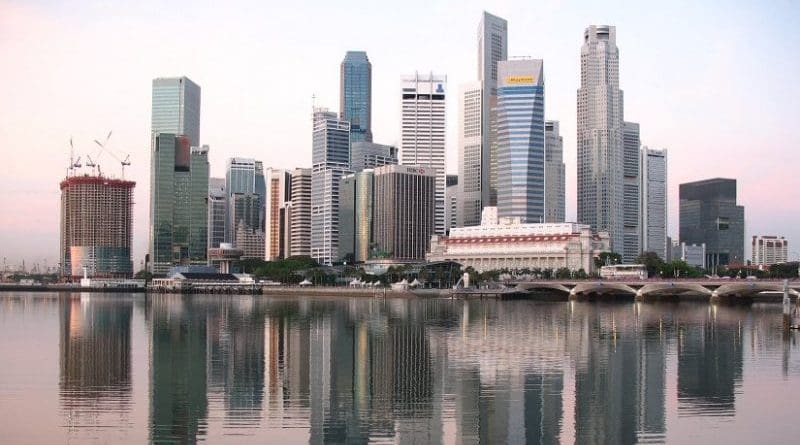Singapore’s 4G SAF: Creating New Advantages – Analysis
By RSIS
Historically, the key dilemma facing Singaporean defence planners has been the question how to build a force and doctrine capable of dealing simultaneously with current security threats, while anticipating future challenges amid limited defence resources.
By Michael Raska*
SINGAPORE’S MILITARY modernisation trajectory projects a gradual evolutionary path. The First Generation (1G) Singapore Armed Forces (SAF), during the 1960s-70s, focused on capability-development of individual services. The 2G SAF reflected a period of consolidation and adaptation from service-oriented strategic thinking toward conventionally-oriented combined-arms warfare (1980s-90s). The 3G SAF (2000s onwards) has been viewed in terms of transitioning towards multi-mission type forces with capabilities ranging from defence diplomacy to conventional warfare against wide spectrum of threats.
In the process, the SAF’s doctrinal orientation and operational conduct has also shifted significantly in its character. In the 1970s, the SAF adopted island-defensive “poisoned-shrimp” strategy, which envisioned high-intensity urban combat to impose unacceptable human and material costs to potential aggressors. In the 1980s, the SAF moved towards a “porcupine” strategy that aimed at limited-power projection in Singapore’s near seas and envisioned a pre-emptive posture by transferring a potential conflict beyond Singapore’s territory.
Planning for Hybrid Conflicts
Since the mid-2000s, the SAF has been developing concepts analogous to a “dolphin” strategy – a “smart” or networked SAF leveraging not only precision fires, manoeuvre, and information-superiority capabilities, but also defence diplomacy in diverse military operations in geographically more distant areas from Singapore.
In doing so, the SAF’s gradual 3G force transformation and its resulting capabilities have continued to qualitatively outpace its neighbours in relative terms. Indeed, one can argue that the 3G SAF transformation process – conceptual, organisational, and technological – that enable joint military operations has matured.
Going forward, however, Singapore faces competing strategic narratives in terms of which types of adversaries and contingencies will prove to be the most consequential in the future. For example, the intensifying strategic competition in the South China Sea may restrict the SAF’s freedom of action in potential future crises or even during peacetime operations.
The SAF will have to learn to operate in contested environments characterised by the presence of sophisticated long-range precision strike assets such as ballistic missiles, submarines, and fifth-generation stealth fighters. At the same time, the SAF is facing non-linear threats ranging from terrorism to cyber and information warfare coupled with increasing internal demographic and resource constraints.
The resulting hybrid security environment make traditional defence planning strategies less effective. Traditional planning procedures begin with certain threat assessments. But when threats are unclear or shifting, planners need to hedge – by preparing for different possible futures, and develop a portfolio of capabilities that can prepare people for a range of contingencies. But hedging is also very expensive, particularly with the increasing costs of advanced weapons technologies.
Strategic Agility
Amid conditions of strategic uncertainty, the 4G SAF will therefore need to focus on institutional agility – developing sets of capabilities to anticipate changing conditions in advance of need, while maintaining core operational readiness. To do so, the SAF must build the next generation of competent and committed leaders of character who improve and thrive in ambiguity and chaos. This means investing in professional military education that shapes strategic culture embracing innovation in complex environments.
Historically, Singapore’s strategic culture has paradoxically served both as an enabler and constraint in the SAF’s military modernisation. On one hand, the SAF has been able to assimilate new technologies, maintain high standards in training, readiness, and professional ethos. At the same time, however, Singapore’s strategic culture has precluded an environment supporting individual “mavericks” challenging the established norms through a bottom-up type innovation, while discouraging failure.
The 4G SAF should therefore leverage on Singaporeans with problem-focused, action-oriented, decision-making styles, while shifting its organisational ethos toward rewarding bottom-up initiative, creativity, assertiveness, practicality, simplification, adaptation, flexibility and tactical improvisation. In short, the SAF has to nurture “institutional mavericks” capable of tackling entrenched barriers to military innovation.
Niche Capabilities & Strategic Partnerships
As military-technological gaps in Southeast Asia narrow, Singapore will also have to search for its niche military-technological innovations to create strategic advantages. In this context, the SAF needs to focus more on mapping trajectories of strategic competition and military innovation in East Asia.
Comparative case studies of military innovation trajectories in different geostrategic settings may help Singaporean policymakers to detect change in new approaches to combat; and prompt a debate on the validity of established strategic paradigms and operational art. For example, the newly established SAF Defence Cyber Organisation should begin with developing operational knowledge and concepts in the context of military action in cyberspace.
Ultimately, the military effectiveness of the 4G SAF will depend on the direction and character of Singapore’s defence diplomacy and strategic partnerships. Strategic partnerships shape Singapore’s external environment, prevent potential risks, dangers and threats, and where it proves impossible to avoid them – provide timely and effective joint responses.
Relying on strategic partners may impose greater foreign policy constraints and external dependencies. While this is so, ensuring future interoperability with select strategic partners may tilt in favour of Singapore’s defence, particularly in the context of potential multiple, cascading crises that characterise hybrid warfare.
*Michael Raska is an Assistant Professor in the Military Transformations Programme at the Institute of Defence and Strategic Studies, S. Rajaratnam School of International Studies (RSIS), Nanyang Technological University. Singapore. An earlier version appeared in The Straits Times.

